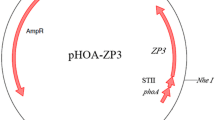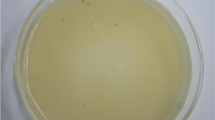Abstract
Objective
To produce a recombinant spermatozoa antigen peptide using the E. coli: PhoA system on a protein chip for screening anti-sperm antibodies (ASA).
Results
The purity of the recombinant spermatozoa antigen exceeded 95% after two-step purification, as assessed using SDS-PAGE and HPLC. The diagnostic performance of a protein chip coated with the recombinant antigen peptide was evaluated by examining ASA in 51 infertile patients in comparison with a commercial ELISA kit. The area under the receiver operating characteristic curve (AUC) was 0.944, which indicated that the protein chip coated with recombinant spermatozoa antigen peptide was consistent with ELISA for ASA detection.
Conclusion
A recombinant spermatozoa antigen was expressed in the E. coli PhoA secretory expression system and its potential application for clinical ASA detection was validated.





Similar content being viewed by others
References
Brincat D, Catania S, Wismayer PS, Calleja-Agius J (2015) Male factors in ART outcome prediction. Gynecol Endocrinol 31:169–175
Campion SR, Elsasser E, Chung R (1997) Amino-terminal charge affects the periplasmic accumulation of recombinant heregulin/EGF hybrids exported using the Escherichia coli alkaline phosphatase signal sequence. Protein Expr Purif 10:331–339
Choi JH, Lee SY (2004) Secretory and extracellular production of recombinant proteins using Escherichia coli. Appl Microbiol Biotechnol 64:625–635
Cui D, Han G, Shang Y, Liu C, Xia L, Li L, Yi S (2015) Antisperm antibodies in infertile men and their effect on semen parameters: a systematic review and meta-analysis. Clin Chim Acta 444:29–36
Domagała A, Kamieniczna M, Kurpisz M (2000) Sperm antigens recognized by antisperm antibodies present in sera of infertile adults and prepubertal boys with testicular failure. Int J Androl 23:150–155
Eom GT, Lee SH, Oh YH, Choi JE, Park SJ, Song JK (2014) Efficient extracellular production of type I secretion pathway-dependent Pseudomonas fluorescens lipase in recombinant Escherichia coli by heterologous ABC protein exporters. Biotechnol Lett 36:2037–2042
Fernandes LG et al (2017) Immune response and protective profile elicited by a multi-epitope chimeric protein derived from Leptospira interrogans. Int J Infect Dis 57:61–69
Lu JC, Huang YF, Lu NQ (2008) Antisperm immunity and infertility. Exp Rev Clin Immunol 4:113–126
Qi L et al (2017) Development of a highly specific HER2 monoclonal antibody for immunohistochemistry using protein microarray chips. Biochem Biophys Res Commun 484:248–254
Selvarajah S et al (2014) Development and validation of protein microarray technology for simultaneous inflammatory mediator detection in human sera. Mediat Inflamm 2014:820304
Sikka SC, Hellstrom WJ (2016) Current updates on laboratory techniques for the diagnosis of male reproductive failure. Asian J Androl 18:392–401
Su Q et al (2016) Epitope-based recombinant diagnostic antigen to distinguish natural infection from vaccination with hepatitis A virus vaccines. J Virol Methods 233:41–45
Vazquez-Levin MH, Marin-Briggiler CI, Veaute C (2014) Antisperm antibodies: invaluable tools toward the identification of sperm proteins involved in fertilization. Am J Reprod Immunol 72:206–218
Xu R, Du P, Fan JJ, Zhang Q, Li TP, Gan RB (2002) High-level expression and secretion of recombinant mouse endostatin by Escherichia coli. Protein Expr Purif 24:453–459
Xu QY et al (2016) Development of a novel protein chip for the detection of bluetongue virus in China. J Virol Methods 234:28–33
Funding
This study was supported by Science and Technology Program of Guangzhou (Grant No. 201604020104), Science and Technology Program of Guangdong (Grant No. 2015A030401040) and the Key Program for health care collaborative innovation of Guangzhou (Grant No. 201500000004-4).
Author information
Authors and Affiliations
Corresponding author
Rights and permissions
About this article
Cite this article
Wang, Mz., Qiu, Zl., Cai, XS. et al. Secretory expression of a novel human spermatozoa antigen in E. coli and its application to a protein chip. Biotechnol Lett 39, 1529–1535 (2017). https://doi.org/10.1007/s10529-017-2377-3
Received:
Accepted:
Published:
Issue Date:
DOI: https://doi.org/10.1007/s10529-017-2377-3




